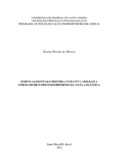| dc.creator | Oliveira, Katrine Pecetti de | |
| dc.date.accessioned | 2021-07-31T17:12:29Z | |
| dc.date.available | 2021-07-31T17:12:29Z | |
| dc.date.issued | 2018-03-28 | |
| dc.identifier.uri | http://repositorio.ufsm.br/handle/1/21669 | |
| dc.description.abstract | In the present study, we aimed to analyze the effect of the feeding habit, phylogenetic history,
size and habitat in the beak shape of the Atlantic Forest passerine birds, as a whole group and
also comparing the two suborders Passeri and Tyranni. We used geometric morphometrics to
quantify beak shape of 1070 specimens from 386 species of the order Passeriform. We
classified each species diet accordingly to the main feeding categories observed for the group,
the habitat as open or closed and how they occupy the vegetation vertical stratum. Using a
phylogeny in the literature, we recovered the evolutionary history of the group. The effect of
size, habitat and vertical stratum in the beak shape were non-existence accordingly to our
analyses. Our results indicate that feeding habits have strong influence on shaping the beak of
passerines, although most of this influence is associated with a strong phylogenetic effect in the
whole group. Suborder Passeri presented a stronger relationship with feeding habit and greater
variability in beak shape, when compared with Tyranii. This high morphological disparity can
be associated with the adaptive speciation events which occurred in the group after their arrival
in South America. In contrast, the beak shape of Tyranni had stronger correlation with
phylogeny and less morphological disparity. This indicates the last has a more conservative
morphology and feeding habits in respect to its phylogenetic history, since most families of this
suborder are mostly insectivores. | eng |
| dc.description.sponsorship | Coordenação de Aperfeiçoamento de Pessoal de Nível Superior - CAPES | por |
| dc.language | por | por |
| dc.publisher | Universidade Federal de Santa Maria | por |
| dc.rights | Attribution-NonCommercial-NoDerivatives 4.0 International | * |
| dc.rights.uri | http://creativecommons.org/licenses/by-nc-nd/4.0/ | * |
| dc.subject | Passeriformes | por |
| dc.subject | Morfologia | por |
| dc.subject | Bico | por |
| dc.subject | História filogenética | por |
| dc.subject | Hábito alimentar | por |
| dc.subject | Morphology | eng |
| dc.subject | Beak | eng |
| dc.subject | Phylogenetic | eng |
| dc.subject | Diet | eng |
| dc.title | Hábito alimentar e história evolutiva moldam a forma do bico dos passeriformes da Mata Atlântica | por |
| dc.title.alternative | Feeding habit and evolutionary history shape the beak of Atlantic Forest passerine birds | eng |
| dc.type | Dissertação | por |
| dc.description.resumo | Neste estudo nosso objetivo foi analisar se o hábito alimentar, a história filogenética, tamanho
e habitat exercem efeito sobre a forma do bico dos Passeriformes da Mata Atlântica, como um
todo e entre as duas subordens Passeri e Tyranni. Para quantificar a forma do bico utilizamos
morfometria geométrica em 1070 espécimes contemplando 386 espécies de Passeriformes.
Classificamos a dieta das espécies de acordo com as principais categorias observadas para o
grupo, o habitat como Aberto ou fechado e a ocupação do estrato vertical da vegetação. Através
de uma árvore filogenética consenso recuperamos sua história evolutiva. Utilizamos regressões
múltiplas multivariadas para verificar o efeito das variáveis preditoras sobre a forma do bico
das espécies. Testamos o sinal filogenético utilizando a hipótese filogenética da árvore
consenso gerada. Realizamos um a análise PGLS para verificar o efeito das preditoras
controlando a trajetória evolutiva do grupo. Não observamos efeito do tamanho, habitat e
estrato vertical sob a forma do bico. Nosso resultados indicam que os hábitos alimentares
exercem influência sobre a forma do bico, mas a maior parte da forma é explicada pela história
filogenética dos Passeriformes da Mata Atlântica. A subordem Passeri apresentou uma relação
significativa com o hábito alimentar e uma maior variabilidade de forma de bico em relação a
Tyranni. Está variabilidade pode estar relacionada com os eventos de especiação adaptativa que
ocorreram no grupo após sua chegada à América do Sul. A forma do bico para subordem
Tyranni apresentou alta correlação com sua história filogenética e menor variação de forma,
demonstrando um conservadorismo filogenético para forma e hábito alimentar já que grande
parte das famílias da subordem são insetívoras. | por |
| dc.contributor.advisor1 | Caceres, Nilton Carlos | |
| dc.contributor.advisor1Lattes | http://lattes.cnpq.br/1920880712756721 | por |
| dc.contributor.advisor-co1 | Melo, Geruza Leal | |
| dc.contributor.advisor-co1Lattes | http://lattes.cnpq.br/3363638250124657 | por |
| dc.contributor.referee1 | Calcaño, Eliécer Eduardo Gutiérrez | |
| dc.contributor.referee2 | Heming, Neander Marcel | |
| dc.creator.Lattes | http://lattes.cnpq.br/2286267588734280 | por |
| dc.publisher.country | Brasil | por |
| dc.publisher.department | Ciências Biológicas | por |
| dc.publisher.initials | UFSM | por |
| dc.publisher.program | Programa de Pós-Graduação em Biodiversidade Animal | por |
| dc.subject.cnpq | CNPQ::CIENCIAS BIOLOGICAS | por |
| dc.publisher.unidade | Centro de Ciências Naturais e Exatas | por |



